| |
|
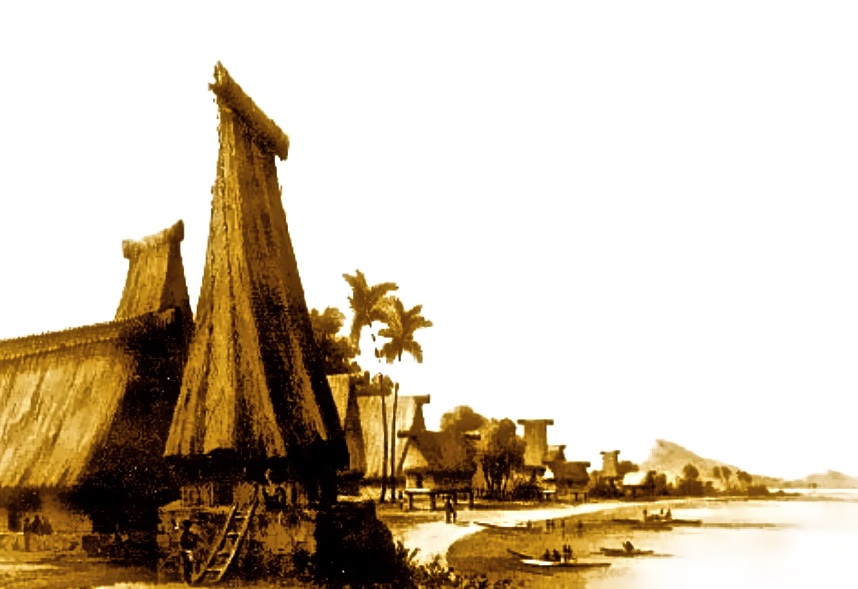
Fiji Coastal View . . . circa 1849 |
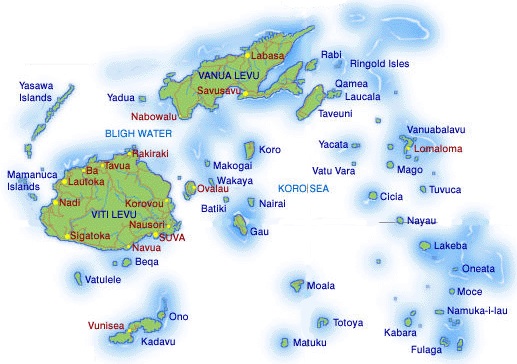
Fiji Islands - South Pacific Ocean |
|
Warfare was a base of Fijian Society
Fighting was literally a 'Way of Life' in old Fiji |
|
"Ships going their I would recommend to go well armed &
niver to be of their gard for althow they are a hospitable people yet
they are Canables & will take every Advantage from their propensity to
stealing, the low class of them in particular. I would recommend never
to go on shoar without being armed for though you may be very friendly
with those you are trading with yet they are always at war among
themselves and those that are their Enomies will be yours"
William Lockerby - Directions for the FeeJee Islands, 1810 |
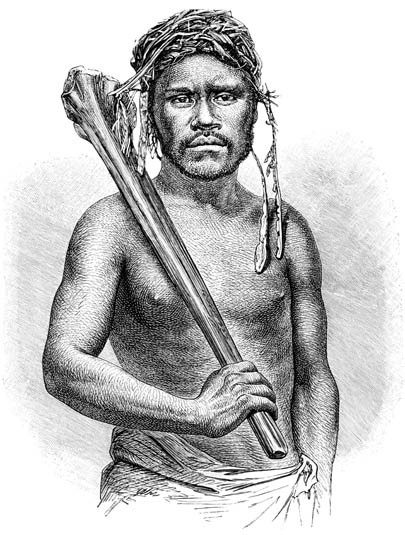 |
Fiji, beginning of the 19th century, few people lived to die of old age,
and men, quite literally, never dared to move about unarmed. Distrust
and suspicion, fear of attack and murder, these were a part of daily
living. The sight of a strange canoe made people uneasy, and women and
children would often flee for their lives at the sight of a stranger.
Assassination amongst men was always lurking nearby.
Fearing assassination, when meeting in a house around the Kava or
Yaqona bowl, men customarily left their weapons just outside the door so
that they could relax confident and safe in each others company. But one
Tui Nayau was clubbed dead while drinking Yaqona. The assassin had his
pole club smuggled into the house by his little daughter wrapped in a
fresh unfurled plaintain leaf, the child crying and asking for her
father, to gain admittance to the house. Sneak raids and murderous
ambushes were a common and constant threat. If the enemy were taken by
surprise, where attackers secretly entered and stormed a town, these
stealth attacks could result in quite large scale massacres, with
casualty rates entering the scores and even hundreds.
Larger wars or "state wars" between confederated chiefdoms tended to be
more openly conducted, war being formally declared with armies marching
to attack fortified towns. Larger still, "widespread wars" involving
several confederations of tribes or states and covering large land
areas, often dragging on for months with thousands of warriors afield.
In some wars, battle and especially massacre casualties climbed into the
hundreds and on rare occasions into the thousands. |
| The most serious and destructive conflicts were those between large
scale tribal confederations or states under high chiefs who were bitter
personal enemies. They involved armies in the thousands of warriors, and
resulted in the sacking and depopulating of large land areas and even
entire islands. Sometimes these conflicts continued until one of the
high rival chiefs was cut down or fled into exile, in which case
plotting vengeance and living to fight again when the opportunity
offered. |
|
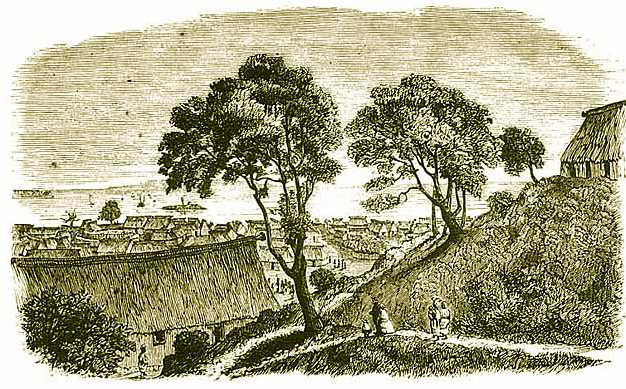
Bau Island City . . . 1855 |
|
"Their villages were mostly perched on the most
inaccessible peak and precipices. These eyries were skillfully fortified
with palisades and galleries for sharpshooters, which, with their well
chosen strategic position, rendered some of them traditionally
impregnable, and until the introduction of European firearms of
precision . . . . they were never taken. I have seen fortified places on
a plain so surrounded by moats, where the mud was armed with stakes and
split bamboos, and so encompassed with clay ramparts and stout
palisades, line within line, that the very taking of them in purely
native warfare was a very tedious or very fatal undertaking. I saw one
village, called Waini-makutu, where the stream had been most ingeniously
diverted into the circular moat, in which it was swirling round the town
on its onward progress, and thus forming a perpetual defense of the
people. An officer of the English army, who had taken some of these
forts of the hillmen, expressed to me his surprise at the skill and
science of engineering they displayed. Covered galleries and lanes, and
curious platforms for sentinels and marksmen, were also features of
these works." - Reverend A. J. Webb . . . 1890. |
By no means were all Fijian forts circular and ditched. Forts in
more rugged country took every advantage of the difficult terrain. They
were built along razor back ridges and on cliffed and virtually
unscalable crags with formidable natural defenses. Some such positions
so strong that a handful of determined men could defy an attacking host.
On even the strongest such natural fortifications however, the defenses
were strengthened by scarping or digging out natural slopes to steepen
them, and the excavating of war-ditches across ridges, and building
artificial defensive terraces. The terraces fronted by fighting fences
on steep slopes. Also, the erection of earthen banks, loopholed loose
stone walls and fighting fences at weak points.To take the forts
required the storming of barricade after barricade and running into
ambuscade after ambuscade. |
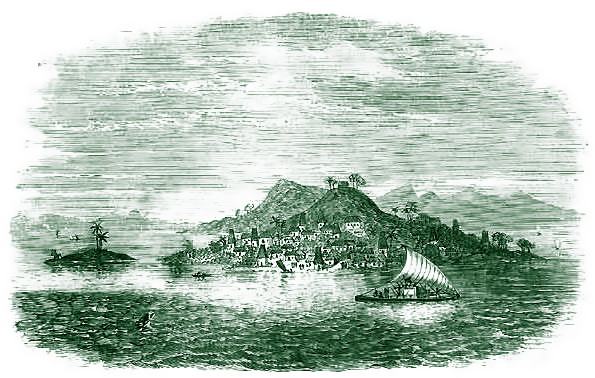 |
| Among other hazards to be faced when assaulting hill forts were the
big rocks and boulders which the defenders dropped and rolled down on
their assailants. Sometimes these were lashed in strategic positions
with vines, the defenders only having to slash the vines to send the
boulders crashing down on their enemies. |
Unpleasant obstacles about Fijian fortifications were the pitfall
man traps called Lovosa, which incapacitated or killed a warrior.
These were set in both gentle and rugged country along paths and
approaches the enemy was likely to traverse, and in gardens he would
plunder. When a retreat was anticipated they would set the in the fort
itself, as a parting surprise for the enemy.
The Lovosa pit fall trap was typically a small hole dug, in the
bottom of which were planted one or more upward pointing hardwood spikes
or skewers of split bamboo, called Soki. The mouth of the pit was
camouflaged twigs covered with turf, leaves or grass.
Larger and deeper Lovosa into which men fell headlong to impale
themselves on the stakes they contained were also used, but to a lesser
extent.
As defenders retreated into the fort, in order to render the forcing of
the gate more dangerous, the Fijians employed calthrops
consisting of a variety of small sharp spikes called Soki, which
were stuck upright in the ground. These Soki were baked and
hardened, and then poisoned. The Soki were usually slivers of
split bamboo or sharp hardwood spikes, or the barbed tail spike of the
stingray, also broken glass, were all used. Each Soki was cut or
charred part way through where it protruded from the earth to encourage
it to break off in the foot.
The Soki were also placed in the narrow stream channels leading
through Mangrove swamps to hinder the enemy, wound his scouts and
generally delay his advance. |
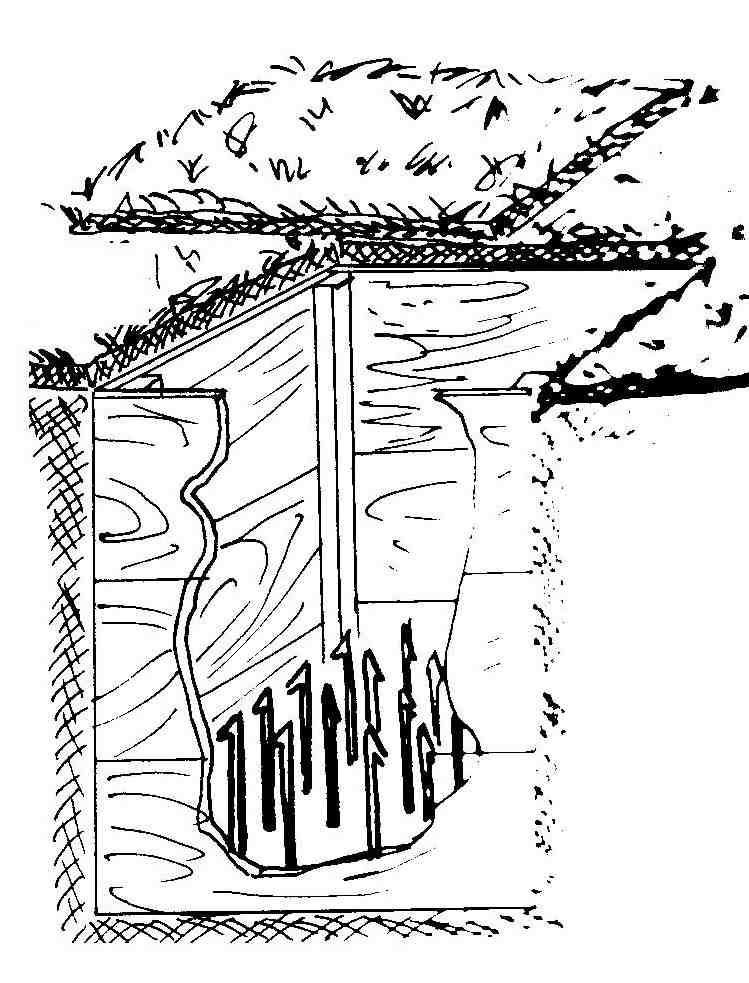 |
|
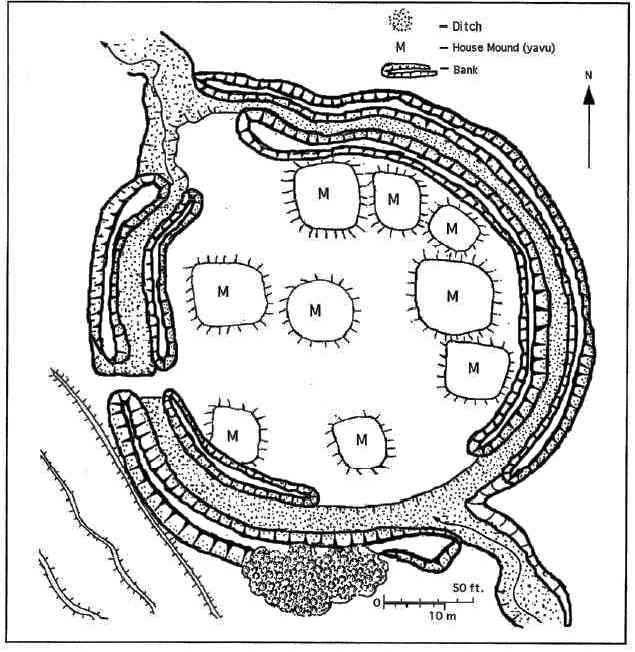
Fijian Fortifications Diagram |
"These are the days of education, and in their way the Feejeens are
on the alert: they rub human flesh over the lips of their children, and
put a portion into the infant's mouth, that it may be nourished by its
juice and trained in the practice of cannibalism!"
Reverend Walter Lawry . . . 1850Fijian children grew up against a
violent and bloody background. They grew up in a land where killing was
glorified and common place. They received ample psychological and
physical training to take their places in a society geared towards
warfare. War, with its bloodshed, cannibalism, and violent Gods was a
natural state for them from infancy onwards. Their histories and legends
extolled the martial deeds of their heroic warrior forefathers. |
|
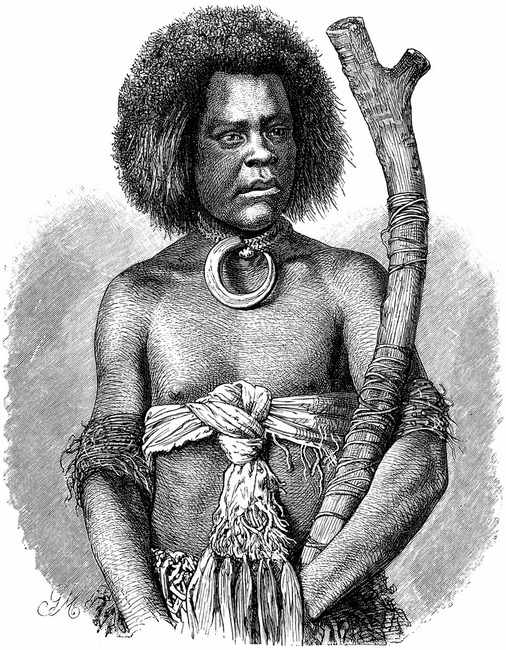 |
Children's games naturally reflected the society they grew up in and
often centered on war and cannibalism. Quote Reverend John Hunt . . .
1858, "It is particularly painful to see them acting a cannibal feast.
One of them will feign himself dead, and the others carry him about,
singing the cannibal song."
Children orphaned by war or murder were encouraged to nurture vengeance,
being disparagingly known as 'the children of the dead' until they grew
up and paid back their parents deaths in blood.
Children practiced on each other with bows and arrows of cane without
hardwood points, but instead a cushion of "Tapa". Through such games and
more formal training by their fathers, boys became skilled in the
various Fijian weapons, and in the equally important art of dodging the
clubs, spears and arrows of the enemy.
Rough mock battles (particularly fights with Vudi stalk coconut frond
midrib clubs) continued until manhood. The youths of a town often
challenging their visitors or neighbors to such competitions, which were
known to end in lost tempers and broken limbs.
More realistic training occurred on the battlefield. Boys accompanied
the army to carry extra weapons for the warriors and to help in
dispatching the helpless enemy wounded, as well as mutilating the dead.
When a large number of enemy children were captured, they were sometimes
brought home alive so that the boys of the victorious tribe could have
some live practice, shooting them, spearing them with their scaled down
weapons or clubbing them to death. |
The Fijian warrior did not rely on a shield or armor, but depended
rather on his well developed agility and alertness. Games taught
accuracy in throwing and an agility in dodging, applicable to the
throwing club or the spear. In one game teams of men or boys, supplied
with citrus fruit, stood one to one at 20 meters both throwing and
dodging until a hit signified a kill. This until one side was wiped out.
Bushcraft and further accuracy were learned on pig hunting excursions
with their fathers and on their own hunting. The Fijian warrior absorbed
in his youth the stealth and bushcraft which were to serve him well as a
warrior in later life, using ambushes as his specialty. The warrior had
to be alert, for example, to the harsh alarm squawks and rattles of the
large Parrots, which might indicate hidden human presence in the bush
nearby. Then again, noisy and static presence of a number of these birds
about the track ahead almost certainly indicated an ambush party was
lurking in the undergrowth.
A tally of kills made with a war club was often kept by means of
nicks or notches on the head or handle, or by boring small holes in the
shaft, another common method being to inlay a tooth from each victim in
the club's head.
In Fiji, a youth could only obtain true warriors status by killing an
enemy with a war club as distinct from all other weapons. A coward whose
club was still unstained with blood at the time of his death was doomed
to pound human excrement with his dishonored weapon in Balu, the
afterworld, onward into eternity. |
|
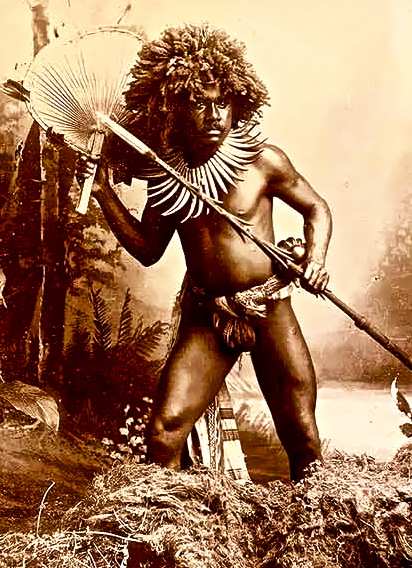 |

Particularly bold and stealthy were the Lone Warriors
known as "Bati Kadi"
Translated 'The Teeth of the Black Ant'
Those who infiltrated the enemy line by night to silently slay
both sleeping foes and drowsy sentinels
|
|
 |
| Fijian war could be extremely deadly. In addition to the massive
wound trauma inflicted from the weapons, the Fijians used vegetable
poisons on their arrows. "There are many independent towns, and
especially in the interior, of which nothing more than their names is
known by the people on the coast."
Reverend John Hunt . . . 1858
Many remote and particularly violent hill tribes of the larger islands
were laws unto themselves, with the bolder tribes raiding almost at will
then retreating into their mountain fortresses, where none dared pursue.
"In native fighting, fences were thrown up by the attacking party,
starting at long distances from the village to be attacked and making
slight advances and fresh fences at intervals of days or weeks. In some
cases it might be months before any actual assault was made. The
attacking party might return home, neither party having come into close
conflict. Numbers of people were at times slain by parties out for food
or skirmishing round. In all fighting the attacking side ravaged the
country for food belonging to the enemy, and according to the quantities
of food, so the duration of a fight might be determined." - Georgius
Wright . . . 1916
As an attacking army advanced on their fortifications, the defenders
usually ventured out long distances to obstruct them, skirmishing,
ambushing and, if unsuccessful in stemming their advance, gradually
falling back on the defensive works.
Both sides sent out scouts far ahead of the main body to ascertain
enemy strength and movement, while friendly chiefs secretly passed on
military information. |
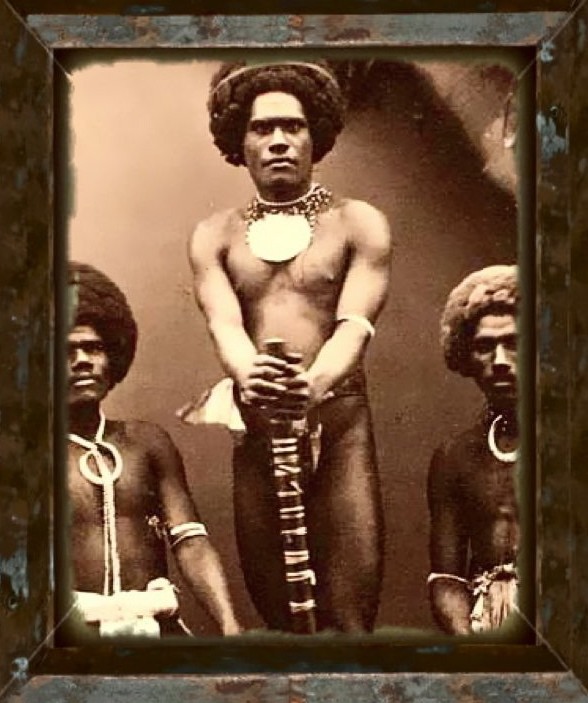
Colo Highland Warriors |
|
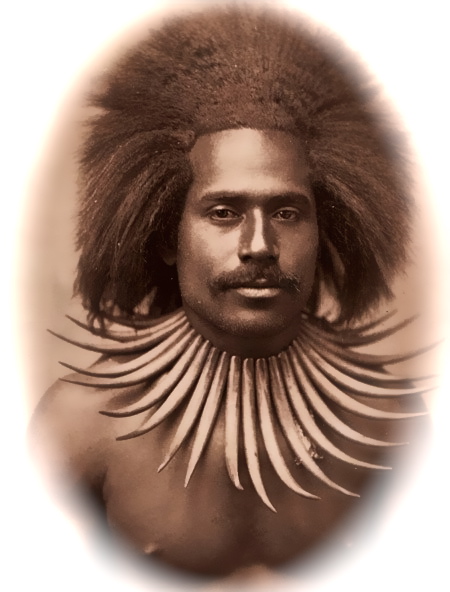 |
Each contingent of allies camped separately in its own
individual field encampments, under the command of hereditary chiefs.
In attacks on strongly fortified positions individual warriors made use
of all available cover as they came within effective sling, bow or
musket shot range. The battle usually initially consisting of back and
forth sniping at extreme range. The defenders would pour out showers of
arrows, sling stones, spears and musket balls, with the women and
children joining in with bows and arrows. The defenders frequently
sallied out on the offensive, often sending the attackers running for
their lives. Back and forth chases were typical of these sallies and
counter attacks, the fighting splintering into a series of single
combats with the warriors hewing at each other with clubs and battle
axes.
Sometimes, however, two large groups of warriors clashed head-on at
close quarters and heavy casualties were caused in a few minutes of
vicious hand to hand fighting with clubs, spears, battle axes, throwing
clubs and clubbed muskets, with warriors on the outskirts sniping into
the melee with bow, sling or musket. Some of these hand to hand fights
were savage to the extreme, and over the din of shell battle trumpets,
shrieks, musket shots, clash of club on club, and crunch of club on
bone, rose the war cry of the warriors as they killed. Each clan having
its own distinctive local killing war chant.
The classic Fijian ambush tactic on a grand scale was the Cuka-ni-valu,
translated 'the fishing net of war'. In short, ambush by encirclement.
The ambushing force hid in the bush in a large U, about a track likely
to be used by the enemy. |
| The battle line forming the base of the U lying across the path,
while the wings of the U lay some distance back, paralleling the path on
either side. Ideally, the enemy column marched unsuspectingly into the
open end of the U, and ran up against the battle line forming its base,
which engaged it as the two flanking wings rushed down on either side
with their ends closing in to cut off the enemy column as it retreated.
|
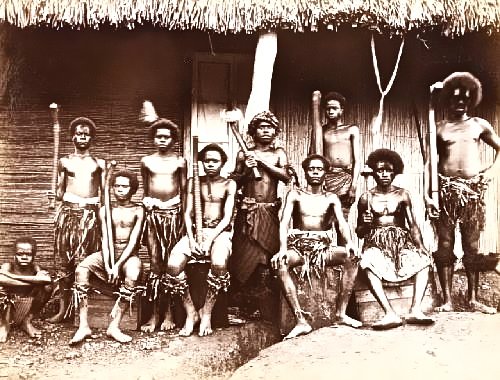
Viti Levu Highlands . . . circa 1881 |
In war, it was always the duty of the women, assisted by the stoutest of
the boys, to feed the warriors. They supplied all the delicacies of the
sea coast including fish, cockles, native lobsters, coconut and taro
puddings, etc., and they willingly and cheerfully endured the hardships
of the campaign.
The women also played a useful support role in the actual fighting
sometimes. They assisted by stationing themselves on prominent hills and
calling down information on the enemy movements, to their warriors and
sometimes luring the enemy into an ambush. Like the boys, the women
finished off enemy wounded.
If a town was taken by force or an army routed afield, the survivors
fled for their lives in panic, with the enemy in full homicidal pursuit.
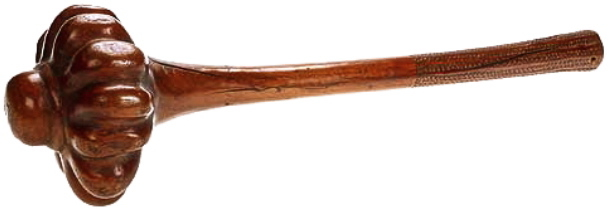 |
|
 |
 |
|
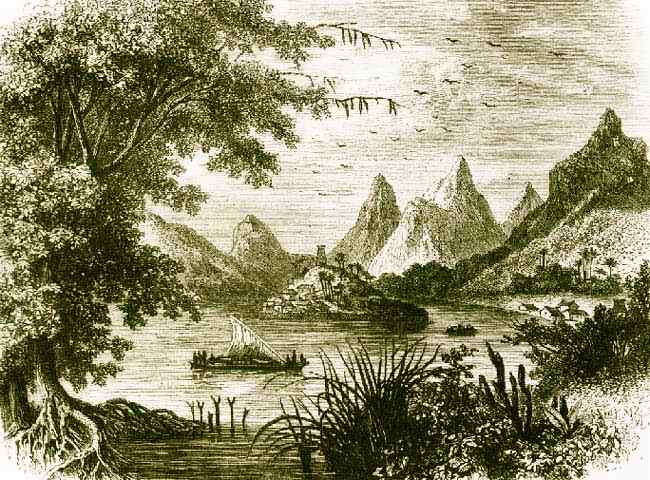 |
|
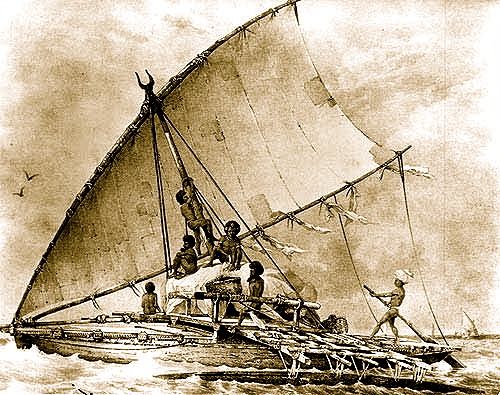
Fijian Outrigger Sailing Canoe |
Warfare at Sea
Invading Fijian armies often traveled long distances to
wage war, being transported from island to island by canoe. A fleet of
war canoes and the warriors transported by it were known as a "Bola",
the Fijian term for a hundred canoes.
Small and quite large scale sea battles were commonly fought. Some of
these sea battles involved large vessels big enough to be regarded as
full blown naval engagements. Most numerous, however, were murderous
incidents involving small canoes in petty warfare.
In the ambush tactic known as "Waqa-ubi" warriors lay hidden in a canoe,
which was allowed to drift ashore as if derelict, and then they sprang
out to attack their enemies, who were coming down to secure the craft.
The huge, plank built, double-hulled "Drua", some of
which exceeded thirty meters in length, were capable of carrying large
contingents of warriors, in addition to their sailor crews, with the
largest Drua carrying in excess of 250 passengers on deck.
|
|
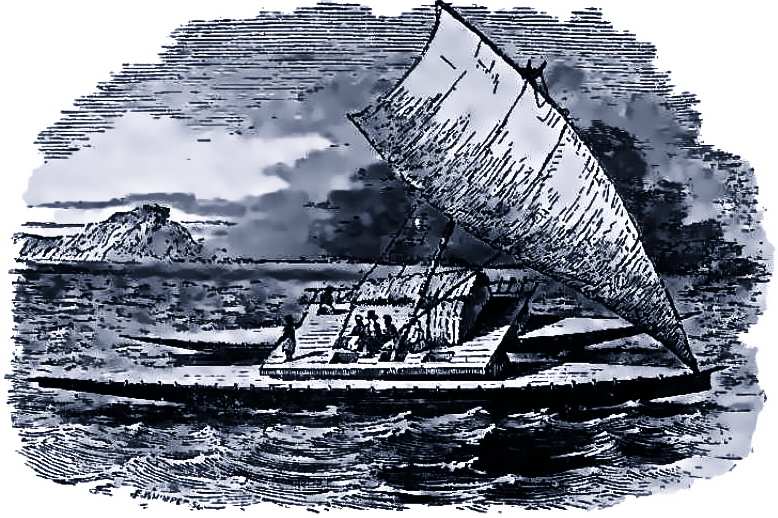
Fijian Double Outrigger Canoe |
The huge, plank built "Camakau" outriggers could also transport
large numbers, as could the larger of the "Tabilai" fighting canoes,
which were either double-hulled like Drua, or had a single hull and an
outrigger like Camakau, the ends of the hulls having been modified by
being thinned down, with a meter and more of solid wood left at each end
to allow for more effective ramming.
The basic battle tactics were to run down and attempt to ram an enemy
canoe amidships to sink or disable her, the warriors in the latter case
boarding to fight hand to hand. Another tactic was to maneuver to
windward of the outrigger hull of the enemy canoe and try to cut through
the rigging, dropping her heavy sail and yards crashing onto her crew
and warriors, entangling and engulfing them, whereon the attacking
warriors boarded to club, spear and shoot them through the sail.
As the enemy canoes drew near each other they exchanged showers of
arrows, sling stones, spears, bullets and occasional cannon balls. |
| The warriors next boarding as they closed to fight with spears and
clubs in a fierce melee, which often ended in the wiping out of one of
the crews, unless they were able to swim ashore or to a friendly canoe.
Survivors were mercilessly shot and speared in the water as they swam
for their lives. Cannon were widely used aboard large canoes in running fights and to
bombard shore positions. The Drua and other large canoes were engaged
and even taken by attacking swarms of smaller canoes. |
|
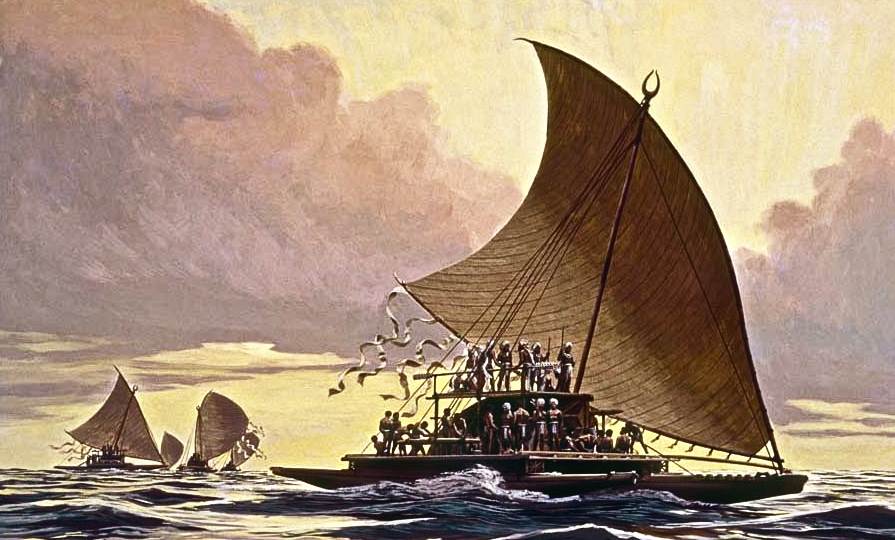
Fijian Drua |
|
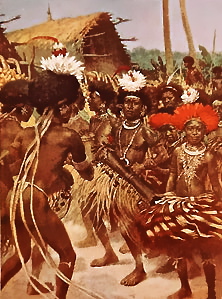 |

There were a myriad of Gods in old Fiji - for every
locality had their own Gods
One of the better known War Gods was "Cagawalu the Great" of Bau
Cagawalu stood ten fathoms tall! |
|
The War Gods sanctioned and demanded
both war and human sacrifices for religious purposes! |
Fijian religion was inextricably mixed with war and cannibalism. It
developed over hundreds and possibly thousands of years of warfare and
was admirably suited to the needs of a martial society. Like many other
religions it was a major cause of bloodshed.
Quote the Reverend John Hunt, 1858, ". . . . it must be lamented that
their worst crimes are sanctioned, and are continually promoted, by
their divinities, who are not only cannibals and adulterers like
themselves, but have pleasure in those that are such." |
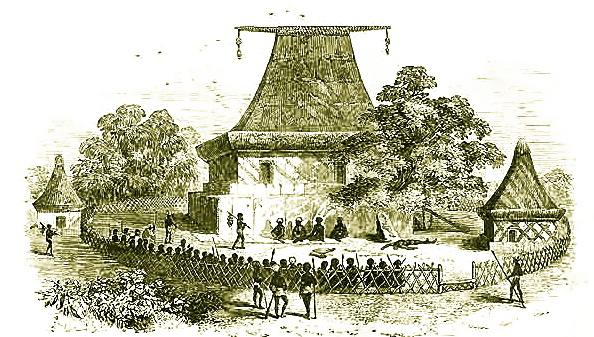
Fijian Temple |
Hatred was carefully nursed and kept smoldering in songs and prayers
and by personal sacrifice, so that when the opportunity for vengeance
came, the Fijians were quick to seize it. Revenge did not stop with the
killing of the enemy, but was, along with religion, principle forces
behind Fijian cannibalism. Before embarking on a raid or war the
Fijians conducted religious ceremonies, and consulted the Gods in an
attempt to insure success in the campaign, and in some cases, to render
the warriors invulnerable to the weapons of their enemies.
"God Houses" or Bure Kalou had interiors that often resembled
armories, with rows and bundles of spears stacked in the rafters, and
muskets, bows and arrows, war clubs, and throwing clubs hung about the
walls. All weaponry coated glossy black with the soot from the fire kept
constantly smoldering, and often eerily festooned with cobwebs. |
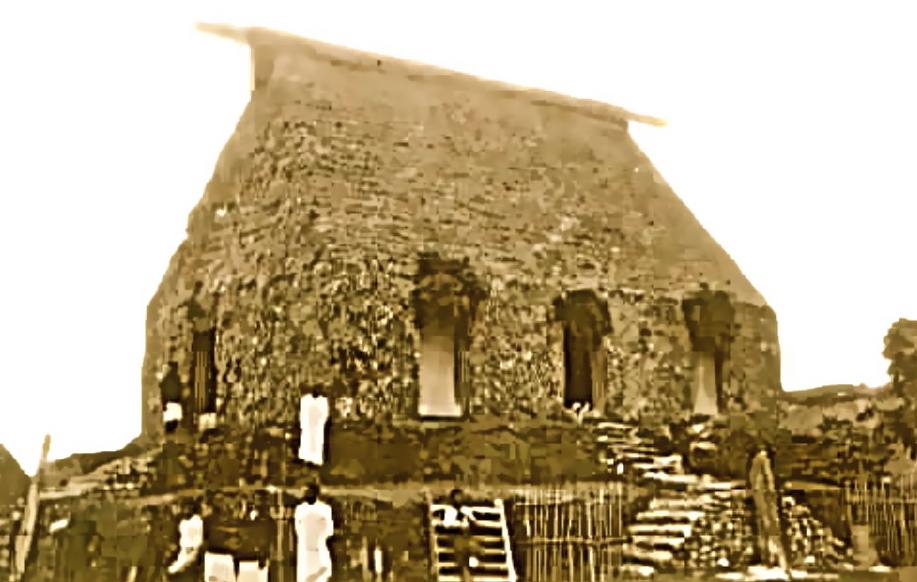
Cannibal Temple Bau Fiji |
Some of these weapons had been presented as offerings made to the
Gods when consulting them through the medium of the Priests, or they
were weapons of deeper religious significance, having killed enemies and
been presented to the War God to ensure his protection against enemy
weapons in the future. For instance, a warrior might present a spear
with which he had killed, and so gain the War God's protection from the
spears of his foes. The weapons stored in Bure Kalou seem
generally to have been regarded as Ka-tabu or sacred objects that
ordinary people did not handle, and thus they hung untouched for year
upon year. But some spears from Bure Kalou were used in combat.
These were more prized the older they get. Glazed with smoke and dirt,
and consecrated by the War God, wounds from these spears are certainly
fatal, while the same kind of wound from a new spear or one kept by it's
owner, will heal.
For at least several days before a fight the warriors usually
abstained from sexual relations in an attempt to insure the success of
the expedition. Religious ceremonies were conducted under the direction
of a priest to make the warriors "Vodi" or invulnerable. |
|
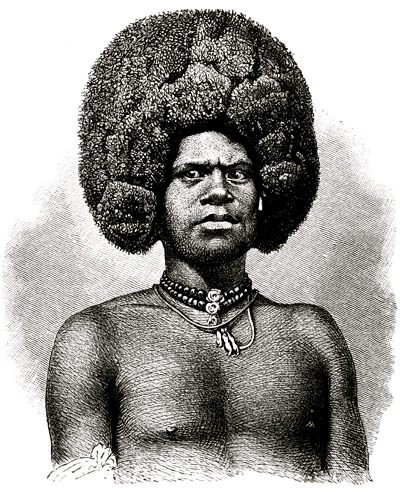 |

"Cannibalism among this people is one of their
institutions; it is interwoven in the elements of society; it forms one
of their pursuits, and is regarded by the mass as a refinement."
Reverend Thomas Williams . . . 1884 |
|
Sanctioned and indeed demanded by Fijian religion,
cannibalism allowed revenge and vindictiveness to be carried past an
enemies death. Some of the principal chiefs and priests of Fiji were
fond of human flesh to the point of addiction, but in being so were
serving their religion and society. |
|
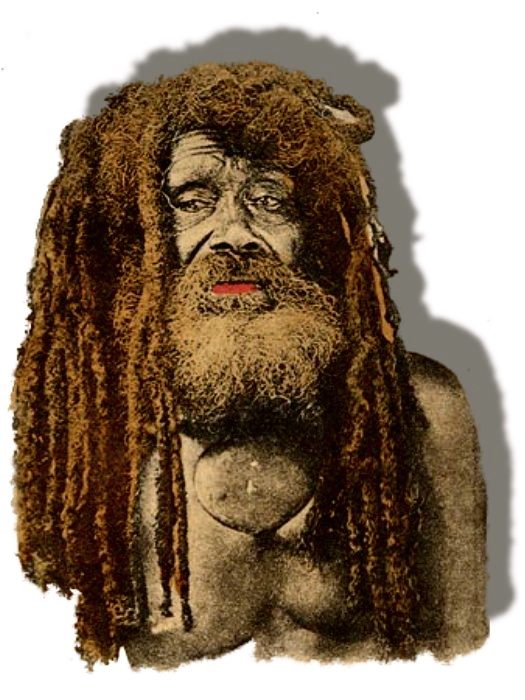 |
If the war or raid had been particularly successful,
Manumanu-ni-laca consisting of living or dead enemy children swung
in baskets or by their heels from the sail yards of the canoes as
victory banners. Nearing home shore, to broadcast that they had killed,
long poles repeatedly splashed the water, and the warriors singing and
dancing the "Cibi", Death Dance, while the Lali slit drums
thundered out the "Derua" Death Beat.
At the outskirts of town came the lewd Dele or Wate dance
by the women, who, appearing naked in public upon this occasion, and
bringing into the open and heightening the tensions of the sexual
undertones, which keep cropping up in Fijian warfare. Erskine . . .
1853, describes for us, "I saw that their animosity was so great, that
they did not consider the enemies being killed and eaten sufficient to
gratify their revenge, without deriding and degrading them as it were,
after death, which the young girls were doing in a lewd kind of dance,
touching the bodies in certain nameless parts with sticks as they were
lying in a state of nudity, accompanying the action with words of the
song. I found out afterwards that the opposite sex were always selected
for the purpose of making the disgraceful end of their enemies
notorious."
Before the Temple the warriors flung the bodies at the feet of the
principal chief and reported their exploits. The chief thanked them and
ordered the priests to present the bodies to the War God. Having been
offered to the War God, the heads of the bodies were shattered against
the Vatu-ni-mena-mona, the "Braining Stone" column set
upright in the ground outside the Temple, thereby sacrificing the brain
to the appetite of the God of War. |
| Feelings ran high while the flesh was slowly cooking, the warriors
doing their Death Dance, the women the lewd Wate, until the tension was
broken in a frenzied sexual orgy. Normal social restrictions broke down
for the night. Women were copulating with warrior after warrior in a
scene the European eyewitnesses could only hint at, although stressing
its licentious nature.
An anonymous European beachcomber relates witnessing a particularly
wild orgy in 1809, "That night was spent in eating and drinking and
obscenity the blood drank and the flesh eating seemed to have a
maddening effect on the warriors. I had often seen men killed and eaten
but I never heard or saw such a night as that. Next morning many of the
poor women were unable to move from the continuous connections of the
maddened warriors."
Armies and war parties in the field generally ate the flesh of enemy
bodies or Bokola, as bodies destined for the oven were called. With a
minimum of ceremony and ritual, the mutilated corpses were cut up,
wrapped in Vudi plantain leaves, and cooked in pit ovens or Lovo.
Concerning one of the great Viti Levu cannibal chiefs, circa 1827,
William Mariner said, "He was not in the habit of sacrificing his
prisoners immediately, (finding them perhaps too tough for his delicate
stomach), but of actually ordering them to be operated on, and put in
such a state as to get both fat and tender, afterwards to be killed as
he might want them. |
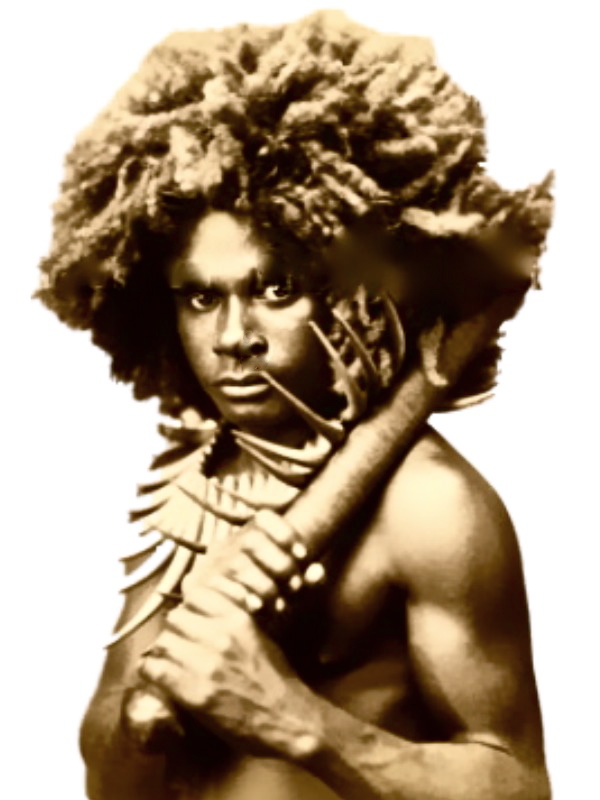 |
|
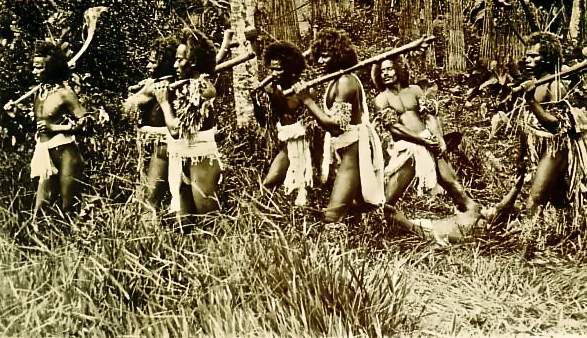
Fijian Warriors . . . carrying
Victim |
|
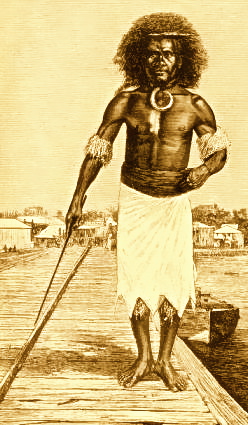 |

A tally of kills made with a war
club was often kept by
Nicks or notches on the head or handle
Boring small holes in the shaft
Another common method being
Inlay a tooth from each victim into the clubs head |
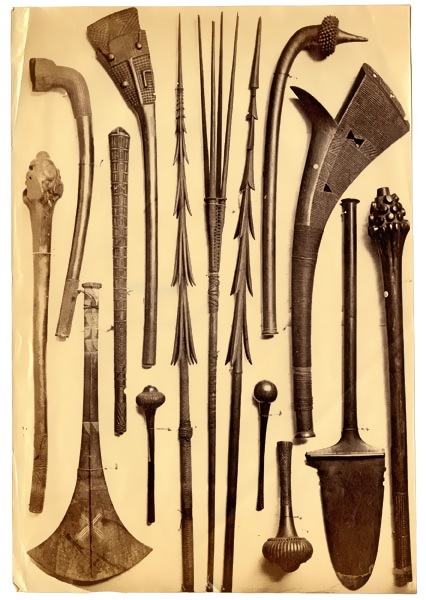 |
The Pacific is the tribal club center of the world and there is a good
and practical reason for this. Hardwood trees were abundant in most of
the Pacific, while iron was virtually non-existent before the late 18th
and early 19th centuries. A Fijian war club was the most cherished weapon of the Fijian
warrior. It was designed and made for specific purposes and there are
approximately thirty distinct and diverse types of native weapons used
by the Fijians.
A club used to kill many enemies was believed to have a life power of
its own or Mana. A Fijian War club with large amounts of Mana were
sometimes placed in a temple to the gods of war, and became ritual
objects in funerary rites and certain craft ceremonies.
Clubs are aggressive, one-on-one offensive weapons requiring skill,
strength, speed and agility, and this fits both the Polynesian idea of
waging war and their concept of individual worth. In Polynesia, war was
an activity fought between groups, but waged by individuals, each
seeking to prove his personal prowess. As a result, the competition for
fame and Mana (personal charisma and power) within the Polynesian
warrior class was intense. It was quite a common, for example, for Maori
war leaders to fight one on one duels as proxies for their armies, and
there were complex rules for these jousts.
In fact, the Polynesians had elevated club fighting to an art form, and
young boys in Fiji, Tonga, Samoa and New Zealand spent hours mastering
the arm, body and foot moves necessary to use various types of club
effectively – skills their lives would depend on.
Of all the Polynesian people, the Fijians were the most prolific club
makers. They had perfected the art of growing clubs by tying young |
| branches at right angles to the trunk so that they could be
harvested as L-shaped billets with a short, thick arm to form the head
of a club.
They also delighted in producing many different types, often with a
specific function in mind. The totokia, for example, had a long point
at the end of the head which could be used to neatly pierce a hole in an
opponent’s skull once he had been felled by the broad side. Each Polynesian culture had its own favored style of warfare and
produced the clubs required to execute it. The Fijians were experts at
all types of club warfare, and are well known for long clubs whose
heads had sharp edges – real bone breakers – but they are perhaps best
known for the short ulla or round headed throwing club. Each Fijian
warrior would go into the fight with three or four tucked into his belt.
Some clubs had a very bloody career before being hung, much notched, in
the Temple of the God of War, those of great warriors being of as
notorious repute, and as widely feared, as the masters who wielded them.
Broken bones were a common occurrence in club fighting, and were
effectively splinted when not too badly shattered. Crushed fingers, an
occupational hazard of the club fighter, simply were amputated on the
spot by the injured man, using a kai shell. |
|
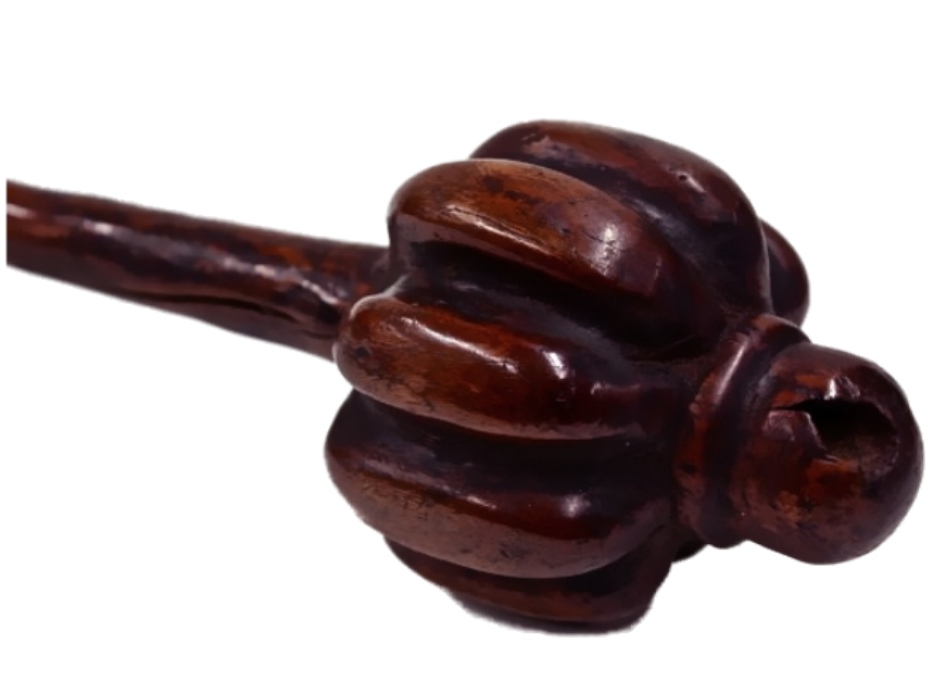 |
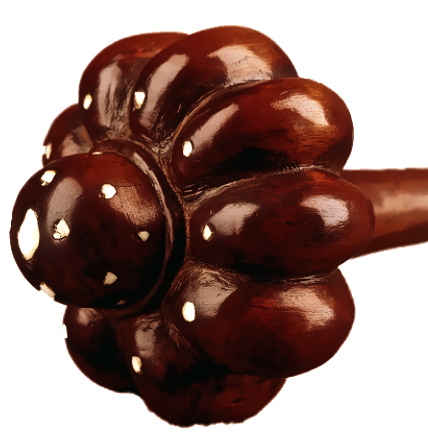 |
|
Fijian Hardwood War Clubs |
|
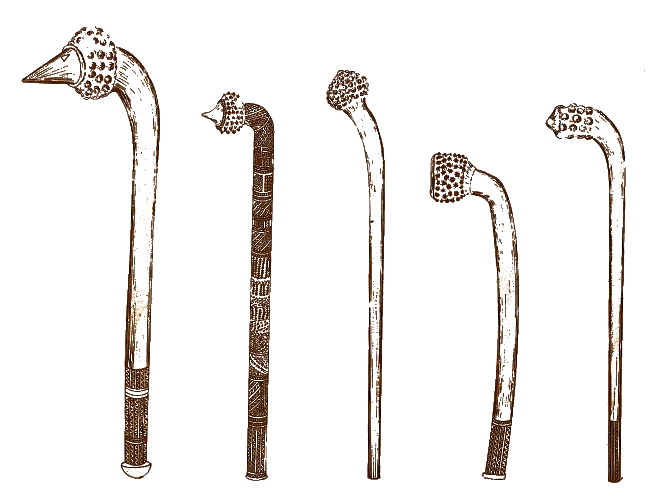
I Tuki - Battle Hammers (Skull Crushers)
Buried with Chiefs or Great Warriors
Borne by the Ghost for the hazardous journey to Balu . . . the Afterlife |
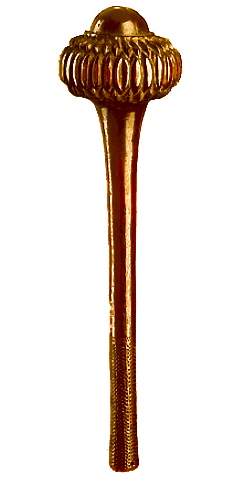 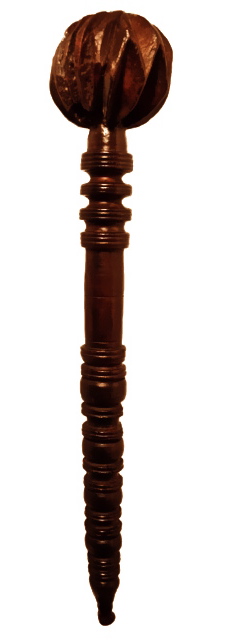 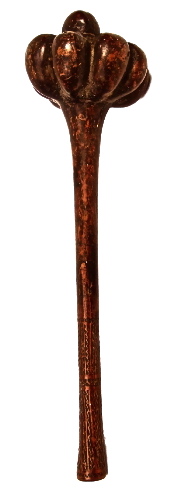
I Kolo - Throwing Clubs
Hurled with Great Precision
Favorite Implement of Assassination |
|
Fijian Hardwood "Totokia" Beaked
Battle Hammer |
|
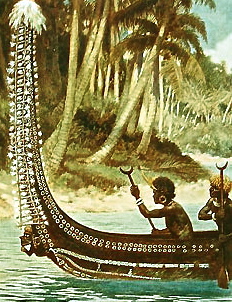 |

Like other Fijian weapons
Spears were made within strictly formal, traditional types, and
categories
One particularly horrible spear variety
Made of a wood which swelled and splintered when wet
Bursting within the bloody wound
|
| "Of Fijian spears or javelins there is a great variety, having from
one to four points, and showing a round, square or semi-circular
section. Some are armed with the thorns of the stingray, some are
barbed, and some formed of a wood which bursts when moist so that it can
scarcely be extracted from a wound. They are deadly weapons, generally
of heavy wood, and from ten to fifteen feet long. One variety is
significantly called 'The Priest is too Late'." - Reverend Thomas
Williams . . .1884 |
| Throwing spears or Moto were major Fijian fighting weapons,
ranging in length from 1.5 to over 4 meters, most being at least 3
meters long. They were used in high numbers until the end of traditional
Fijian warfare, though they gradually became scarcer as the musket
became more and more common on the battlefield. |
| All Fijian spears other than Saisai, can generally be said to
have been made of a single length of wood, with the head and barbs
carved from the shaft. The multi-pronged Saisai was unique
among Fijian spears in that it was made up of several pieces of wood,
three or four long prongs. The heavy Saisai were designed and
used for war. To render them more dangerous each prong of the Saisai
was commonly tipped with a single stingray tail spike. This spear
was much used by chiefs. Similar, lighter spear tips were used for
fishing and were called by the same name.
Timbers used for the more elaborately barbed spears included a variety
of hardwoods, but principally Sacau or Bulu (Palaqutum
hornei), a dense, heavy wood which was soaked in water prior to carving,
and indeed could be stored underwater for many years without rotting.
Other utilized hardwood trees included, Vesi or Greenheart (Intsia
bijuga), Bau (Pittosporum brackenridgei), Makita (Parinarium laurinum),
and Vesivesi (Pongamia pinnata). In addition to these, a variety of palm
woods were commonly used for plainer javelins, including the Balaka
(Balaka seemanni). These palm wood spears are easily recognized by the
black and brown stripes running down their shafts.
The heads of the spears were generally round in section, inflicting a
puncturing rather than a cutting wound. The lack of sharp cutting edges
to the head meant the spear was unlikely to induce instant and shocking
massive bleeding unless it hit a major organ or blood vessel. Since the
spears could not be relied upon to take instant effect it was desirable
to make their extraction from the wound more difficult. Therefore, the
spears had heavy, exaggerated barbing of the spearheads. Extraction of
the spear from a body wound by pulling back on it was a virtual
impossibility without a major surgical operation.
In addition to these wooden barbs, the Fijians commonly tipped their
spearheads with a circlet of barbed stingray tail spikes or
Voto-ni-vai. |
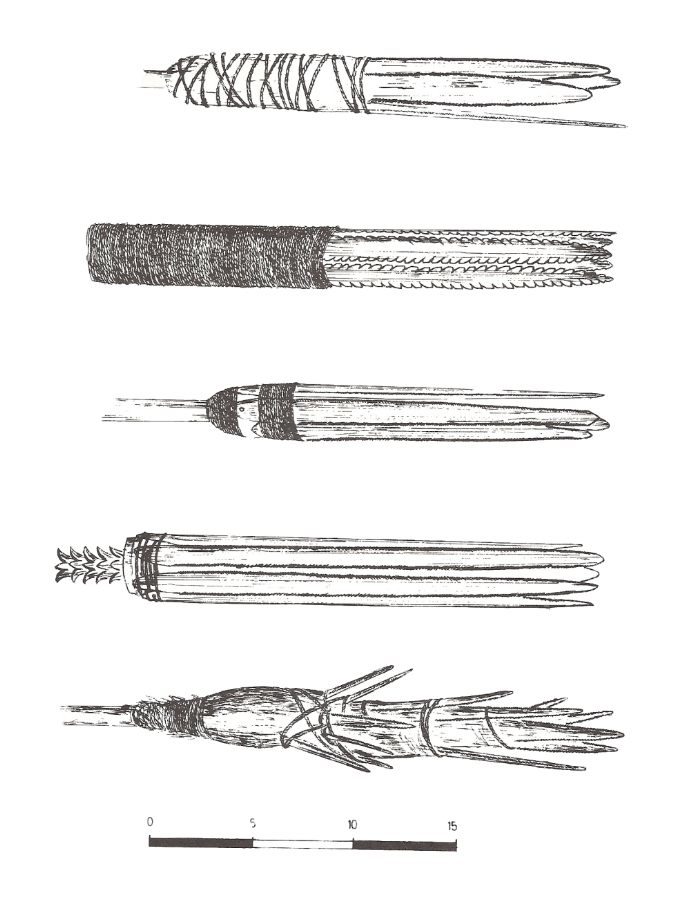
Fijian Spear Tips - Voto-Ni-Vai (centimeters) |
| They penetrated the wound as part of the spearhead but flared out
and remained within even relatively shallow wounds, sliding off the
spearhead as the weapon was withdrawn. The points were obtained from the
tails of stingrays, which are armed on the upper surface towards the
base with one or more large bony and serrated spikes, which can cause
painful and dangerous wounds. The points broken off in the wounds, the
barbs require surgery to remove them safely. These stingray tail spikes
were in great demand as spear and arrow points. |
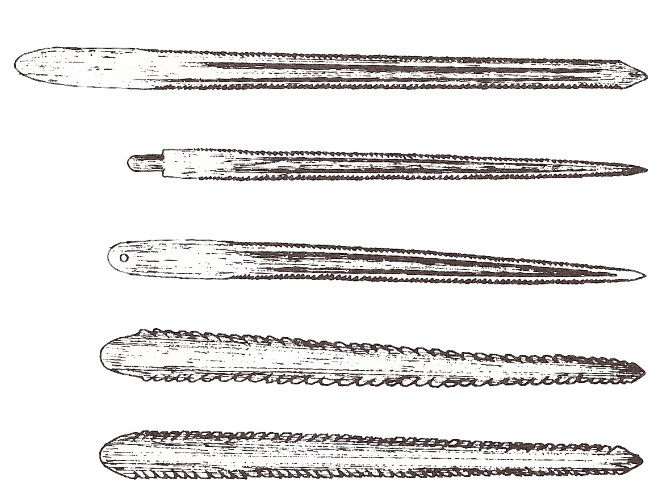 Stingray
Tail Spike - Arrow and Spear Points |
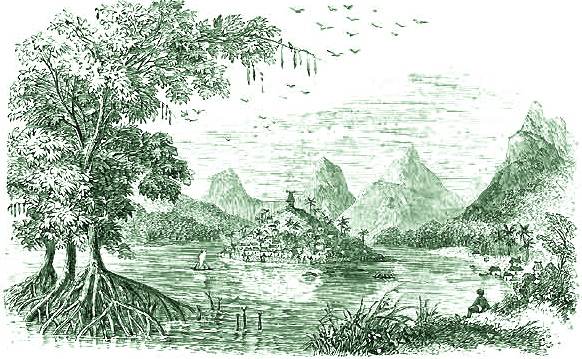 |
| According to A. H. Ogilvie . . .1924, "the Voto-ni-vai or thorn of
the skate . . . . was a splendid assassin's dagger, and the man who had
that thrust into his neck or abdomen while asleep would be very unlikely
to recover." |
|
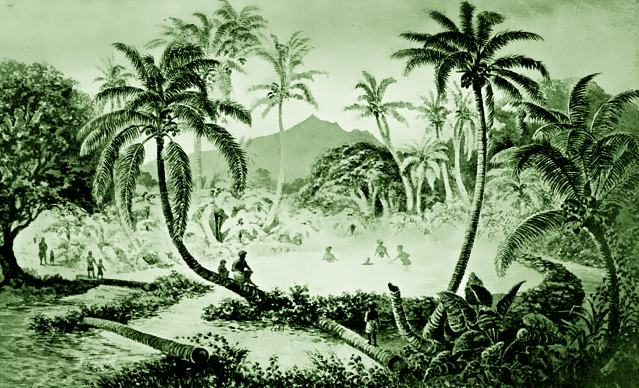 |
The Fijian spear was mostly thrown from the unaided hand of the
warrior. But sometimes throwing cords and throwing sticks were utilized
to propel the fighting spears over longer distances. The knotted end of
the cord was wound once round the spear shaft, the cord passing over the
knotted end so that while it was kept tight it gripped the shaft without
having to be tied, but fell loose if the string was allowed to slacken.
The length of the cord lay along the spear shaft, its looped end being
placed over the index finger of the throwing hand.When the spear was
thrown the looped end of the cord remained attached to the index finger,
the knotted end automatically whipping free from the spear shaft after
the spear left the hand. The cord thus lengthened the throwing arm, and
gave the spear a revolving motion like that of a rifle bullet. This
greatly increased range and velocity.
Fijian spears were also held for stabbing and thrusting as
circumstances warranted. |
| As the opposing forces closed to within twenty meters and less, the
spearmen poised and quivered their spears ominously in an attempt to
paralyze their foes, then suddenly hurling them with great force and
accuracy, and men skillfully dodging them at the last moment.
Spears were of great value in defensive warfare, being hurled out
onto exposed attackers from behind fighting fences and from the gate
platforms.
Spears were often used as incendiaries by attackers. Pieces of barkcloth
or dry grass were to their points and ignited. The flaming missiles were
then hurled over the fighting fence to land among thatched roofs within,
setting them ablaze.
Warriors usually carried a war club or battle-axe in addition to a
bundle of spears. It was traditional to rush in and and club a man after
he fell from a spear, as there was more credit and status pertaining to
a war club.
As with the war clubs the various Fijian fighting spears figured
prominently in dance and ceremony, as well as on the battlefield. They
also had a religious role in the construction of Temples, Bure Kalou.
Spears were decorated for dance and ceremony. The heads and barbed
sections of the spears were often gaily painted with red, white, yellow
or blue paint. Brightly colored Parrot feathers were tied in little
puffs to the spearheads.
During the nineteenth century bayonets and crude iron spearheads made by
ship's blacksmiths were commonly used as points on the traditionally
wooden headed fighting spears. |
|
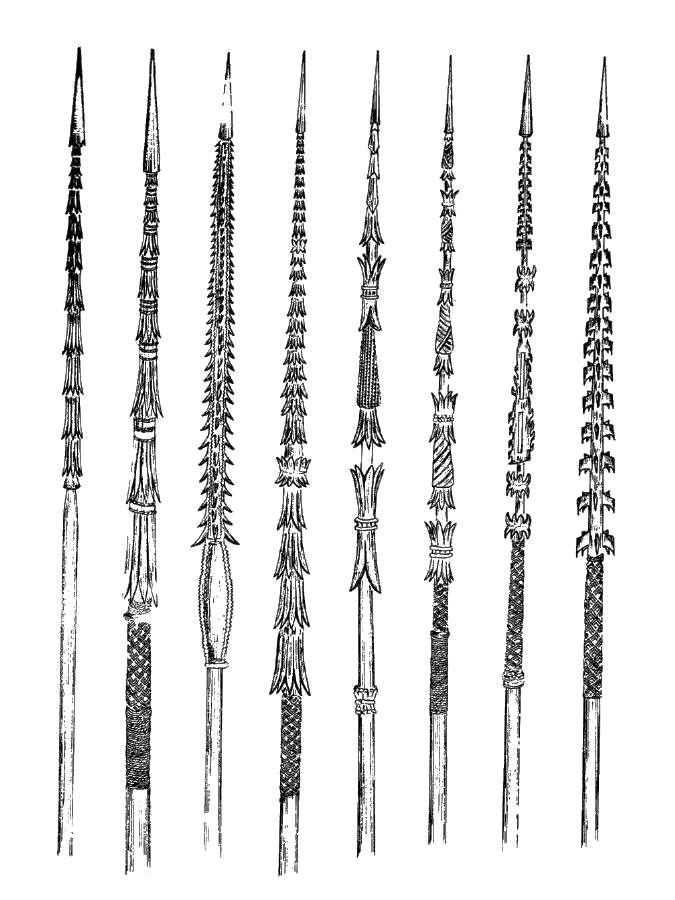
Fijian Spear Types (Sokilaki, Sirusiru, Se-ne-nui, Kaka) |
|
Extreme examples of the Sokilaki type spear
(First 4 Spears)
Sirusiru the barbs of which point both forward and backward to
make extraction from a wound more difficult (Next 2 Spears)
Se-ni-nui - literally "the coconut flower", a rare form (7th
Spear)
Kaka was a common type, characterized by its heavy, hooked barbs
(8th Spear) |
|
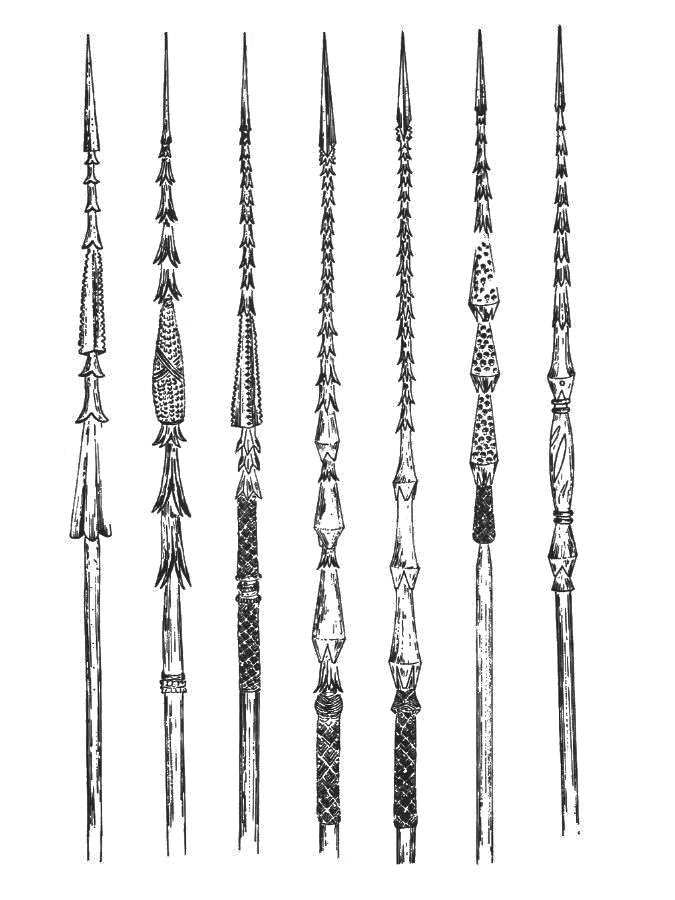
Fijian Spears (Tavevatu) |
|
Unknown types for first three spears.
Tavevatu - A common spear type. It is characterized by the series
of cones beneath the barbs, but more particularly by its head, which is
of quadrangular or diamond shaped cross-section, not round in cross
section like the heads of the other spear types. |
|
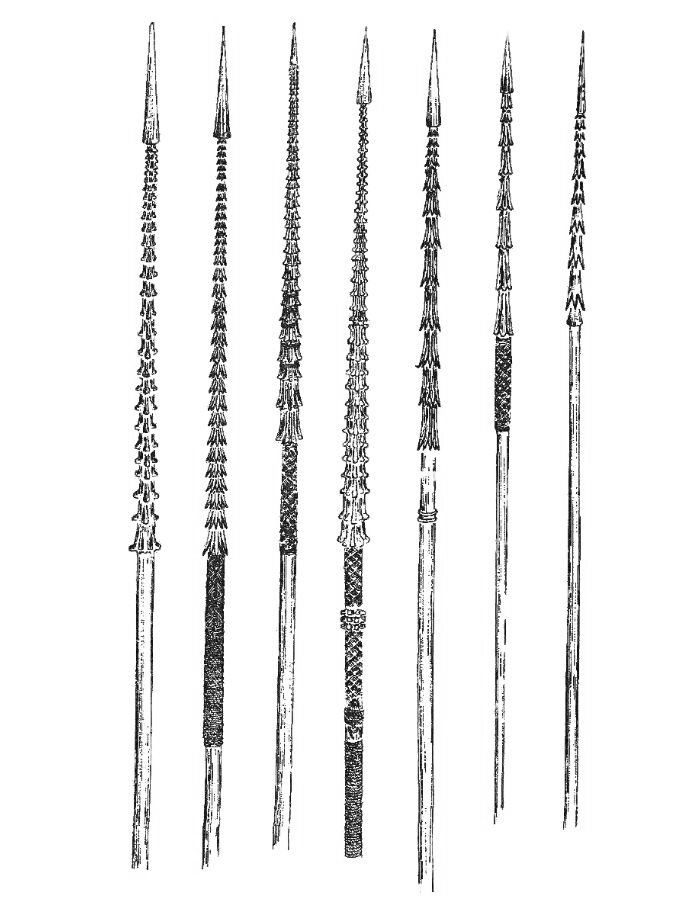
Fijian Sokilaki Spears |
|
Sokilaki - Showing the range in type of these
multibarbed fighting spears. |
| The bow or Dakai was a major Fijian fighting weapon before it
was gradually replaced by the musket. Fijian bows were widely used for
hunting, fishing and war. Typically between 1.5 to 2 meters in length,
most war bow staffs had a groove running down much of the length of the
inside or belly of the bow. Fijian bows were either straight staffs,
plain bows or reflex.
Bows were used in both land and sea fights, battle usually commencing
with a shower of arrows and sling stones in pre-musket warfare. Bows
were used by women and children to defend their town from behind its
fighting fence. Bows were of particular value in attacking and defending
fortifications, in ambush, and in bringing down fleeing enemies. Fire
arrows were used to burn a town into submission. |
|
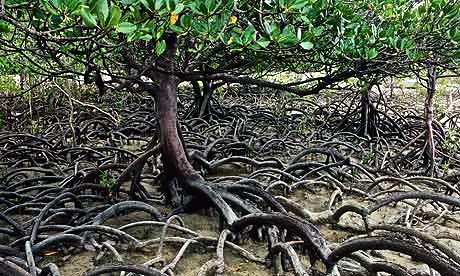 |
In Fiji, the usual method of bow making was to split a naturally
curving Mangrove root or branch lengthways, and to use the two
strips so obtained to make two bows, unless one half was rejected by the
craftsman. The groove on the belly of Fijian bows is caused by the
cleaning out of the sapwood or tube of pulpy pith which runs down the
middle of the Mangrove root, because in many cases the
root was not split dead centrally. The root strip was roughed out with a
adze, the sap groove cleaned out, and the stave scraped smooth with
bivalve shell scrappers. Ash was then rubbed into the wood of the staff
and it was smoked and oiled. The bow string was plaited in a two or
three string strand from the inner bark of the wild hibiscus, other
barks occasionally were used.
Bows were generally stored unstrung, only being strung when it became
necessary to shoot them. |
|
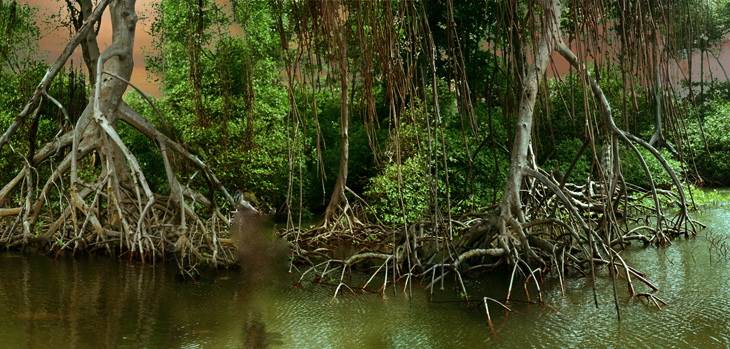 |
| Fijian reed war arrows were usually just over a meter long, into one
end of which was inserted a hardwood spike, usually slivers of
Mangrove or other hard woods, with or without a small stingray
tail-spike point to make extraction from the wound more difficult, or
were heavily barbed along one side, the backward raking barbs being
thinned down where they rose from the shaft of the arrowhead so they
snapped off readily within the wound. Unbarbed arrowheads had a thin
fish bone inserted on either side, just behind the tip, pointing
backwards and almost flush with the shaft so that they would not snap
off while penetrating the body, but would effectively prevent the arrow
from being pulled back out of the wound. |
|
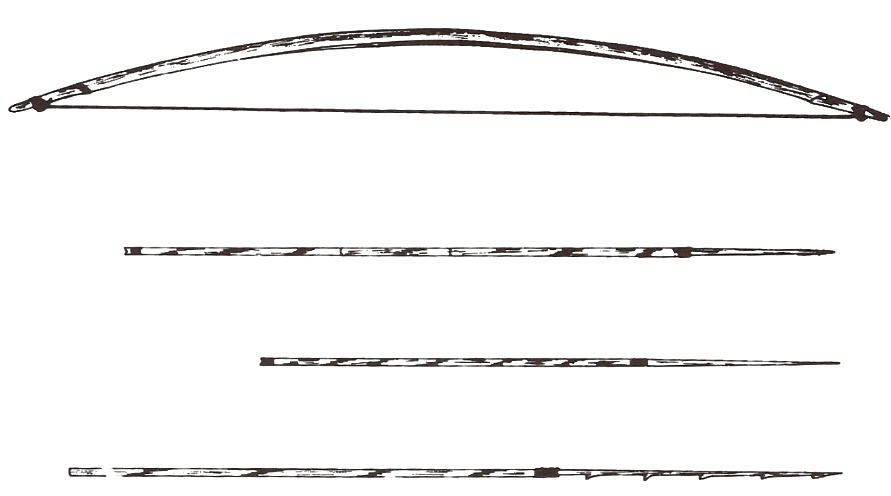
|
The bow took a more deadly toll days and even weeks after the
conflict, as barbed arrow heads in the body could only be removed by
surgery, while punctured lungs and guts led to lingering deaths. The
Fijians were well aware of the absolute necessity of removing all
particles of an arrow or spear from a wound, and knew full well that the
dreaded lockjaw or tetanus was most likely to arise from the deep
puncture wounds inflicted by their arrows. The Fijians developed
sophisticated surgery to deal with combat wounds caused by arrows and
barbed spears.
In an attempt to increase the potency of their arrows, the Fijians
sometimes coated their arrowheads with vegetable poisons, the most
widely known of which was the gum of the Mavu-ni-toga Tree (Antiaris
toxicaria), a rare tree in Fiji, and one specially cultivated in temple
compounds. |
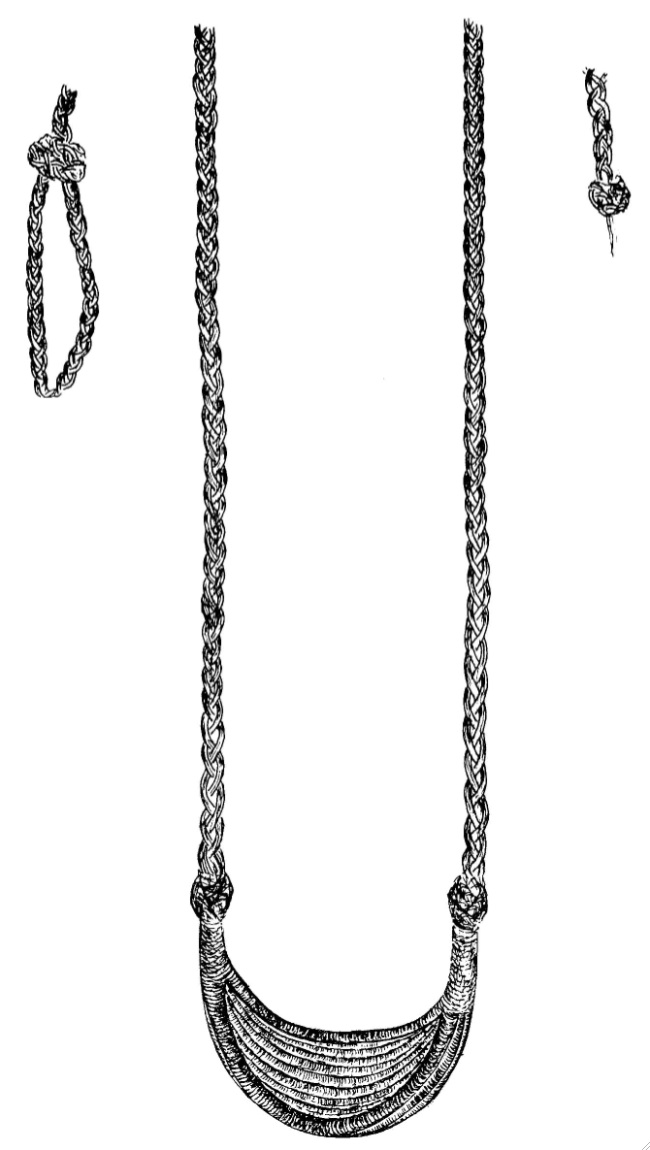
Fijian Sling |
Early accounts by traders and beachcombers show that
battle usually opened with volleys of sling stones and arrows before the
warriors closed to fight at close quarters with spears and clubs.
Clubmen were also armed with slings, as the sling was particularly handy
providing warriors with an effective missile weapon which when not
needed could simply be tied round the waist or upper arm, not impeding
the use of the war club in any way.
The strings of the sling were plaited from the inner bark of wild
Hibiscus (Hibiscus tiliaceus), and in rare cases from human hair. Fine
twine from the Wa Yaka Vine (Pueraria lobata) was used to cover and bind
together the several parallel coir-sinnet cords which made up the basket
or stone pouch of the sling. The two throwing strings which ran up from
either end of the basket, one ending in a finger loop and the other in a
knot, were each generally some 60 to 70 centimeters long.
In using the sling the finger loop was placed over the middle finger of
the throwing hand, the knot of the other cord being grasped between the
thumb and index finger, and the stone placed in the basket. The slinger
swung the sling round once above his head than snapped out his arm and
released the knotted cord, the sling jerking out to its full extent,
sending the stone towards its target.
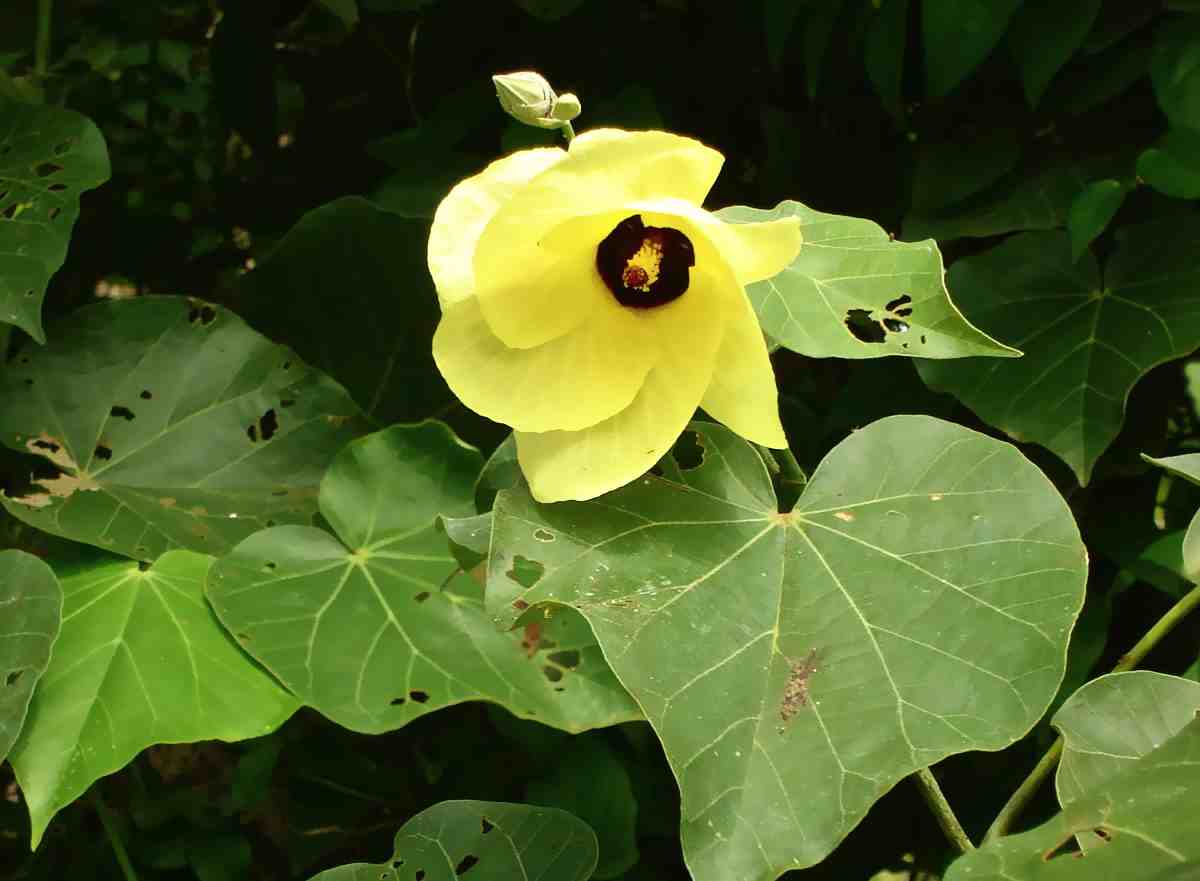
Hibiscus tiliaceus |
|
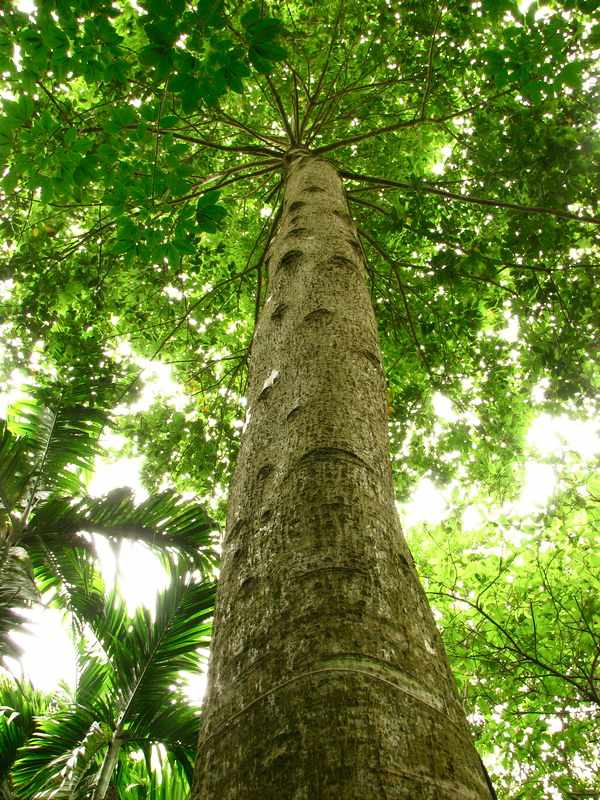
Antiaris
toxicaria |
|
During the nineteenth century heavy axes, hatchets,
knives and swords of various form were introduced to Fiji by European
traders and many were absorbed into the Fijian armory. |
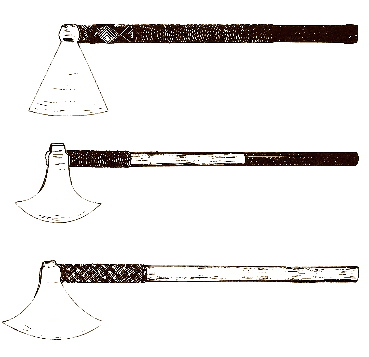
Fijian Battle Axes |
Swords - The swords, mainly sabers and cutlasses saw only
limited use by Fijian warriors. The unpopularity of these weapons can be
attributed to the stroke and grip of the weapon being quite unfamiliar
to the Fijian warrior. An awkward weapon to the Fijians, the sword had
little advantage over the two-handed war club. Knives - The
warriors liked the long bladed butchers knives better and used them
frequently in close quarters melee fighting. With the razor sharp sheath
knife a warrior could step inside the two-handed swing of a clubman,
unused to such a technique, and plunge your knife through the vitals.
Tomahawks - Tomahawks were popular with Fijian warriors, but the
lighter hatchets were less so, because they felt too light and flimsy
for warriors accustomed to swinging hefty Fijian war clubs.
Battle Axes - It was the heavy broad blade battle axes that
were the most popular European weaponry introduced to Fiji. This was
probably because they were used in the same manner as a two-handed war
club. The tomahawk and battle axe heads were fitted by the Fijians with
their own round sectioned hard wood handles, which were carved with a
zig zag grip and multi-colored binding, as was the case with their war
clubs. By the mid 1870's, the axe was replacing the Fijian war club as a
close quarter weapon. |
|
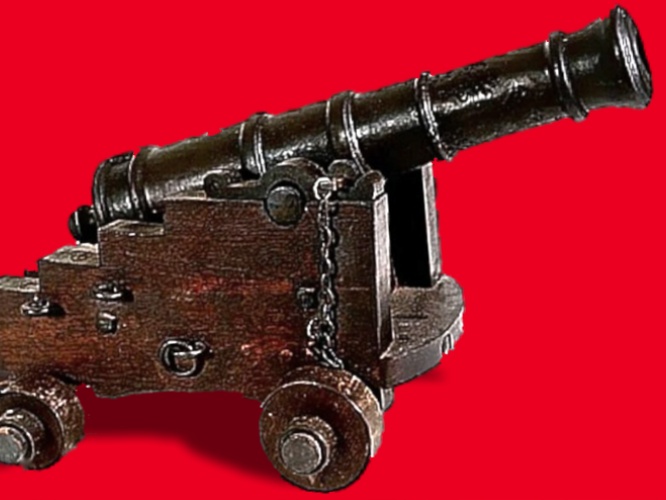 |
 |
| An American ship, hired to bombard the Fiji Island of Bau, calmly
anchored offshore and fired a broadside into the town. But the local
beachcombers, white residents of Bau at the time, prepared a response. A
large cannon was brought to bear on the ship. The second shot struck the
jib-boom and the captain fearing he might be disabled slipped anchor and
sailed out. |
Cannon fire was among the first gunfire the Fijians were
subjected to and its reputation spread rapidly.
Brass and iron barreled, muzzle loading, smooth bored cannon, were used
by the Fijians to a limited degree in their nineteenth century wars.
These cannons ranged in type and calibre from light Pivot Blunder Busses
and Swivel Guns (originally mounted aboard ships as anti-personnel
weapons), and up to three and four pounder cannons mounted on wooden,
small wheeled naval truck carriages, some of which were inlaid with
bone, in the same fashion as war clubs. |
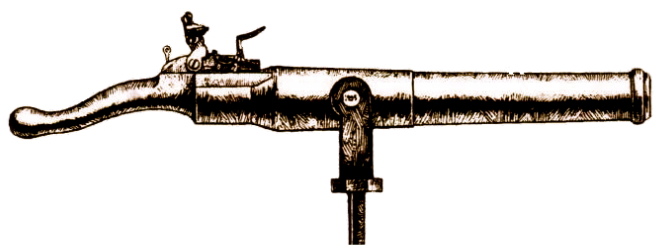
Swivel Gun |
The projectiles used in cannons in Fijian warfare were generally
based on conventional European naval projectiles of the time. At long
range against buildings, earthworks or large canoes, a single heavy cast
iron ball or round shot was loaded. The Fijians, and beachcombers
frugally employed lighter, less effective, rounded river stones when
proper cannon balls were in short supply, which was usual.
Case or Scatter Shot was used at closer ranges against bamboo and
reed fighting fences, canoes and massed groups of warriors, the cannon
acting like a gigantic shotgun. Scatter shot consisted of grapeshot
(tubular canvas bag filled with several tiers of iron balls or musket
balls), which was rammed home over the cartridge, in place of the round
shot. These scatter shot loads were devastating against canoe crews or
groups of warriors, from close range to out to well over 200 meters,
depending on the gun.
Also used was Canister, which consisted of a tin can or cylinder
filled with musket balls. Langrage was a canister filled with
irregular pieces of iron to bring down rigging and sails. |
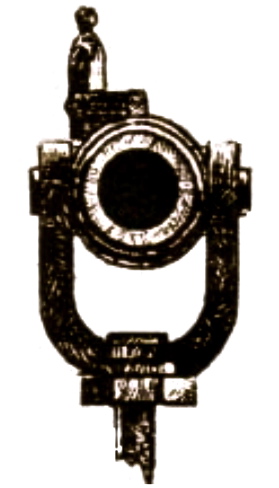
Swivel Gun Frontal View |
With canister, grapeshot and langrage the containers burst on
leaving the muzzle, spewing forth a metallic and rapidly spreading hail
of small ball, each perfectly capable of killing or maiming.
It was common practice to double shot the guns, meaning to ram in two
loads of grape or canister, or a load of scatter shot with a round shot
together, to render them more effective.
Most merchant ships trading in the islands in the first half of the
nineteenth century carried a defensive armament of cannon, and nearly
all the cannons used in Fiji were obtained from shipwrecks or traded
from the captains of foreign vessels.
Due to their weight, cannons were largely confined to fortifications and
siege warfare in less rugged terrain, mostly near the coast or along
navigable rivers. Only a few were transported further inland. |
|
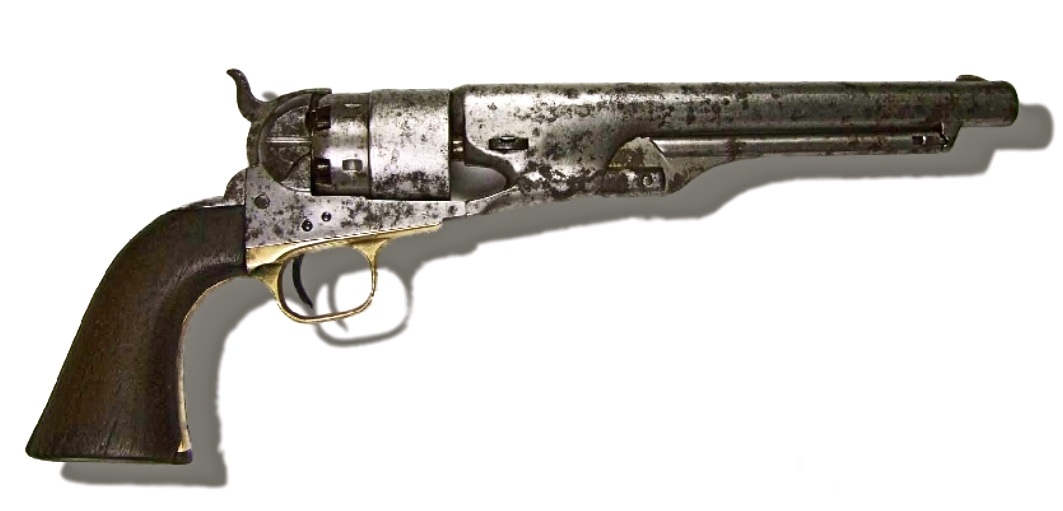
Colt .44 Caliber Army Model . . .
circa 1860 |
In early 1800 the American schooner "Argo" was wrecked on the
Bukatatanoa Reef in the extreme southeast of Fiji. The Argo brought to
the islands the first of a series of foreign diseases, which were to
decimate the Fijian people, and introduced the flintlock musket to the
region.
It was the sandalwood merchant ships that acquainted the Fijians with
firarms. First encounters scared off Fijian war canoes. But by 1808, the
sandalwood cargo ships captains were finding it profitable to help the
local chiefs in their wars. Their crews, with musket and cannon, fought
as mercenaries with the allied natives, in return for bigger and more
easily obtained cargoes. |
|

US M1816 Flintlock Musket |
Another source of firearm education were the "Beachcombers". Lured
by the chance of an easy, lawless life, with multiple wives, and perhaps
more specifically, the treasure hunt for the thousands of silver pillar
dollars wrecked with the brig "Eliza" off Nairai, in 1808, came motley
bunches of shipwrecked sailors, escaped convicts, and ship deserters.
They formed small beachcomber communities under the protection of some
of the major chiefs. They went native and dressed like the Fijians and
"followed the customs of the aboriginals" so as not to be too
conspicuous a target in a fight, and so certainly be killed.
The largest and most violent band established itself on Bau Island,
which by virtue of its canoe fleets and maritime strength held sway over
scattered parts of Fiji. The most notorious and able of this assortment
of multiracial adventurers was one Charles Savage, a survivor of the
Eliza wreck. Another was Paddy Connor, an Irish rogue and lying escaped
convict, who survived on the islands more than thirty years. |
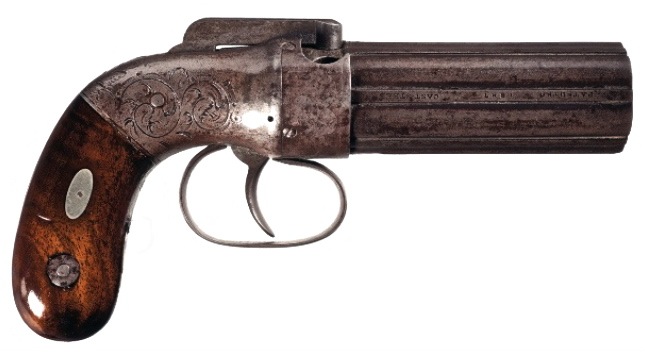 Pepperbox Revolver |
At first muskets and other firearms were only in the
hands of these ragged mercenaries and the crews of trading ships. For
twenty years few but foreigners and the chiefs of larger coastal powers
had the opportunity or dared to use them. Up to about 1830 the musket
was still a novelty over much of Fiji. But its fearsome reputation had
preceded it to most areas, which probably added to the spectacular
results it often achieved when first introduced to an area. Later,
particularly in the coastal areas, where the novelty soon wore off, the
guns passed into the hands of more and more warriors, other than heroes
and chiefs.
"Amongst the booty from the ship were many casks of powder of whose
explosive nature the natives had little knowledge, and of its extreme
danger when accumulated in large quantities, little conception. In one
dwelling . . . were a number of kegs of powder promiscuously placed upon
the floor, in the center of which a fire was kindled . . . . loose
powder was scattered about, and the proprietor . . . . sat on a keg of
powder before the fire, composedly smoking his pipe." W. D. Dix of the
ship "Glide", 1848. |
By 1840 the musket was an increasingly common weapon in the hands of
coast and island dwelling warriors and was even infiltrating remote
mountain districts in the interior of the major islands. But the
traditional bow and sling remained in common use in combat until well
into the 1850's, and played their part in mountain battles through the
sixties, never being entirely replaced.
By 1850, however, the musket was the predominant projectile weapon of
the coastal warrior. It must be stressed however, that firearms never
completely replaced the indigenous weapons in Fijian warfare, clubs and
spears still being the most numerous weapons on the battlefield as late
as 1870.
From their introduction early in the century through to the late 1850's
the Fijians generally obtained their muskets and ammunition by
plundering shipwrecks or in trade with merchant ship captains. Later
they received muskets and ammunition for bringing in trade goods. The
trade in muskets, powder, ball, flints and percussion caps was only
finally stamped out, along with Fijian warfare, after Fiji became a
British Crown Colony in 1874.
The firearm most commonly used in Fijian warfare was the muzzleloading,
smoothbored flintlock musket. Pistols were often worn by chiefs in time
of danger and intrigue, but never caught on with common warriors, who
preferred traditional weapons at close quarters.
Lieutenant Wilkes . . . 1845, of the U.S. Exploring Expedition, who in
his punitive raid on Aalolo in 1840 became convinced that the Fijians
could dodge a gunshot, noted that: "Our party having approached within
seventy feet of the stockade, opened its fire on the fortification. Now
was seen, what many of those present had not believed, the expertness
with which these people dodge a shot at the flash of a gun. Those who
were the most incredulous before, were now satisfied they could do this
effectually."
Few Fijian warriors ever attained any real accuracy with the musket. The
warriors tended to jerk off a shot as the gun came to the shoulder. The
bullets used by the warriors were far from standard and hardly conducive
to accuracy. Not knowing how to cast lead bullets, they were fond of
scatter shot loads, which were a crazy mix of old nail heads and other
scrap, pebbles, or even pieces of broken bottles. |
|
.jpg)

.jpg)
